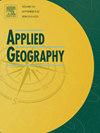Optimizing air pollution sensing for social and environmental justice
IF 4
2区 地球科学
Q1 GEOGRAPHY
引用次数: 0
Abstract
Low-cost sensors have emerged as a new urban technology to provide localized air pollution sensing data. However, common approaches to sensor deployment, whether market-driven or crowdsourced, often reinforce existing data gaps and perpetuate social and environmental injustices. To address this, this paper develops a new location modeling framework that integrates environmental and social justice goals for equitable sensor placement. We propose a gradual covering location model (GCLM) to optimize sensor distribution, considering data for both environmental exposure and sociodemographic vulnerability. Our application to air quality sensing in Chicago (United States) demonstrates the effectiveness of the proposed framework, showing that sensors are suggested to distribute across high-traffic downtown areas and vulnerable communities, providing more equitable coverage compared to existing public, participatory or crowdsourced sensor networks.
优化空气污染感知,实现社会和环境正义
低成本传感器已经成为一种新的城市技术,可以提供本地化的空气污染传感数据。然而,常用的传感器部署方法,无论是市场驱动还是众包,往往会加剧现有的数据差距,并使社会和环境不公正现象永久化。为了解决这个问题,本文开发了一个新的位置建模框架,该框架集成了环境和社会正义目标,以实现公平的传感器放置。我们提出了一个渐进覆盖定位模型(GCLM)来优化传感器分布,同时考虑了环境暴露和社会人口脆弱性的数据。我们在芝加哥(美国)的空气质量传感应用证明了所提出框架的有效性,表明传感器被建议分布在交通繁忙的市中心地区和脆弱社区,与现有的公共、参与式或众包传感器网络相比,提供更公平的覆盖范围。
本文章由计算机程序翻译,如有差异,请以英文原文为准。
求助全文
约1分钟内获得全文
求助全文
来源期刊

Applied Geography
GEOGRAPHY-
CiteScore
8.00
自引率
2.00%
发文量
134
期刊介绍:
Applied Geography is a journal devoted to the publication of research which utilizes geographic approaches (human, physical, nature-society and GIScience) to resolve human problems that have a spatial dimension. These problems may be related to the assessment, management and allocation of the world physical and/or human resources. The underlying rationale of the journal is that only through a clear understanding of the relevant societal, physical, and coupled natural-humans systems can we resolve such problems. Papers are invited on any theme involving the application of geographical theory and methodology in the resolution of human problems.
 求助内容:
求助内容: 应助结果提醒方式:
应助结果提醒方式:


